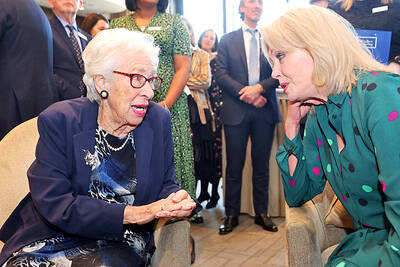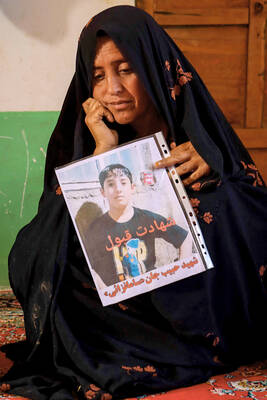After the world missed almost all of its targets to protect nature for the past decade, observers following a new round of negotiations are focusing as much on how goals would be put in place as the headline targets.
Nearly 200 nations were taking part in talks until yesterday, aimed at fine-tuning a draft text to preserve biodiversity by 2050, with key milestones at 2030, which is to be adopted at the UN COP15 conference later this year.
Nations are striving to increase their ambitions in the face of stark warnings that humanity is driving devastating declines in the biodiversity, but the world failed almost entirely to reach a similar set of 10-year objectives set a decade ago at UN talks in Aichi, Japan.
“The Aichi targets were largely missed because of lack of political will and parties not prioritizing them enough,” said Anna Heslop of the non-governmental organization ClientEarth, which is following the talks in Geneva, Switzerland. “There was just a lack of implementation. We can’t afford to be in that position again in 10 years.”
The text under negotiation includes a series of proposals to avoid repeating the same mistakes.
“What we need is a better system for encouraging parties to plan and report, and then the global community needs to do something. It is keeping these three elements is the challenge,” said a delegate, who asked not to be named.
Nations should develop stronger action plans to use natural resources sustainably, the Paris-based Institute for Sustainable Development and International Relations (IDDRI) said.
There should also be a more robust reporting system, with nations periodically measuring progress and passing on data that feeds into a global assessment, it added.
Currently, each nation draws up its national biodiversity plan on a different basis, making comparisons difficult. To address this, the delegations in Geneva are trying to develop common indicators to measure progress.
“Let’s put in place mechanisms for collective and individual review, which will increase the pressure, and this affects ambitions and implementation at the national level,” IDDRI researcher Juliette Landry said.
Conservation groups want national action plans to be updated regularly after COP15 with progress reports and a global stock take before 2030. That way, nations and the international community can see if they are going off track and increase their efforts, but more reporting and administration requires more funding, and biodiversity-rich developing nations say they would need both financial and technological support to meet the obligations.
“You cannot ask people to do spatial planning if they don’t have the means,” a delegate said.
Another IDDRI proposal is the creation of a compliance mechanism, although Landry said that this would not be an exercise in finger-pointing. Instead she said it would show the “gaps between what the countries had planned and what they implemented,” and enable problems to be addressed and for nations to share their experiences.
So far, there has been little appetite for such a mechanism, but without one “all of this process is meaningless,” said Oscar Soria of the advocacy group Avaaz.
“Because nobody will take responsibility and nobody will take the convention seriously from the outside,” Soria said.

Auschwitz survivor Eva Schloss, the stepsister of teenage diarist Anne Frank and a tireless educator about the horrors of the Holocaust, has died. She was 96. The Anne Frank Trust UK, of which Schloss was honorary president, said she died on Saturday in London, where she lived. Britain’s King Charles III said he was “privileged and proud” to have known Schloss, who cofounded the charitable trust to help young people challenge prejudice. “The horrors that she endured as a young woman are impossible to comprehend and yet she devoted the rest of her life to overcoming hatred and prejudice, promoting kindness, courage, understanding

US President Donald Trump on Friday said Washington was “locked and loaded” to respond if Iran killed protesters, prompting Tehran to warn that intervention would destabilize the region. Protesters and security forces on Thursday clashed in several Iranian cities, with six people reported killed, the first deaths since the unrest escalated. Shopkeepers in Tehran on Sunday last week went on strike over high prices and economic stagnation, actions that have since spread into a protest movement that has swept into other parts of the country. If Iran “violently kills peaceful protesters, which is their custom, the United States of America will come to

‘DISRESPECTFUL’: Katie Miller, the wife of Trump’s most influential adviser, drew ire by posting an image of Greenland in the colors of the US flag, captioning it ‘SOON’ US President Donald Trump on Sunday doubled down on his claim that Greenland should become part of the US, despite calls by the Danish prime minister to stop “threatening” the territory. Washington’s military intervention in Venezuela has reignited fears for Greenland, which Trump has repeatedly said he wants to annex, given its strategic location in the arctic. While aboard Air Force One en route to Washington, Trump reiterated the goal. “We need Greenland from the standpoint of national security, and Denmark is not going to be able to do it,” he said in response to a reporter’s question. “We’ll worry about Greenland in

PERILOUS JOURNEY: Over just a matter of days last month, about 1,600 Afghans who were at risk of perishing due to the cold weather were rescued in the mountains Habibullah set off from his home in western Afghanistan determined to find work in Iran, only for the 15-year-old to freeze to death while walking across the mountainous frontier. “He was forced to go, to bring food for the family,” his mother, Mah Jan, said at her mud home in Ghunjan village. “We have no food to eat, we have no clothes to wear. The house in which I live has no electricity, no water. I have no proper window, nothing to burn for heating,” she added, clutching a photograph of her son. Habibullah was one of at least 18 migrants who died